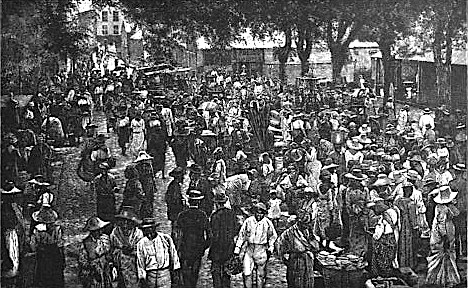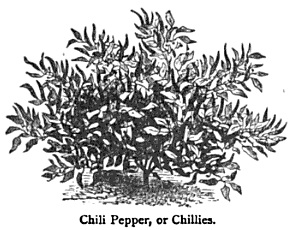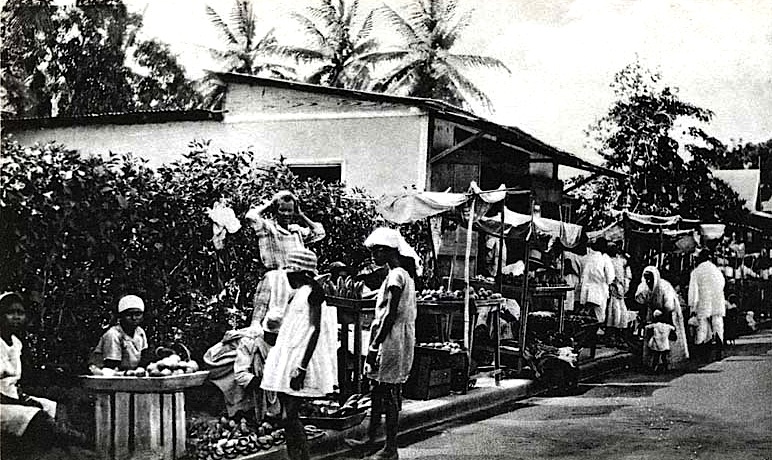By Lafcadio Hearn

Old Marketplace of the Fort, St. Pierre, Martinique
Pimento is an essential accompaniment to all these dishes, whether it be cooked or raw: everything is served with plenty of pimento,—en pile, eti pile piment. Among the various kinds I can mention only the pimmt-cafe, or “coffee-pepper,” larger but about the same shape as a grain of Liberian coffee, violet-red at one end; the piment-zoueseau, or bird-pepper, small and long and scarlet;—and the piment-capresse, very large, pointed at one end, and bag-shaped at the other. It takes a very deep red color when ripe, and is so strong that if you only break the pod in a room, the sharp perfume instantly fills the apartment. Unless you are as well trained as any Mexican to eat pimento, you will probably regret your first encounter with the capresse.
Cyrillia told me a story about this infernal vegetable.
PIMENTO STORY.
There was once a mamma who had ever so many children; and one day she had nothing to give those children to eat. She had got up very early that morning, without a sou in the world: she did not know what to do : she was so worried that her head was upset. She went to the house of a woman-friend, and told her about her trouble. The friend gave her three chopines [three pints] of manioc flour. Then she went to the house of another female friend, who gave her a big trayful of pimentos. The friend told her to sell that tray of pimentos: then she could buy some codfish,—since she already had some manioc flour. The good wife said: “Thank you, macoume,”—she bid her good-day, and then went to her own house.
The moment she got home, she made a fire, and put her canari [earthen pot] full of water on the fire to boil: then she broke up all the pimentos and put them into the canari on the fire. As soon as she saw the canari boiling, she took her baton-leti, and beat up all those pimentos: then she made a pimento-calalou. When the pimento-calalou was well cooked, she took each one of the children’s plates, and poured their calalou into the plates to cool it; she also put her husband’s out to cool, and her own. And when the calalou was quite cool, she put some manioc flour into each of the plates. Then she called to everybody to come and eat. They all came, and sat down to table.
The first mouthful that husband took he stopped and screamed:“Aie! ouaill! my wife!” The woman answered her husband: “Ouaill! my husband!” The little children all screamed: “Ouaill! mamma !” Their mamma answered: ”Ouaill! my children!”. . . They all ran out, left the house empty; and they tumbled into the river to steep their mouths. Those little children just drank water and drank water till they were all drowned: there was nobody left except the mamma and the papa. They stayed there on the river-bank, and cried. I was passing that way just at that time;—I asked them: ” What ails you people?”
That man got up and gave me just one kick that sent me right across the river; I came here at once, as you see, to tell you all about it. . . .
From: Two Years in the French West Indies, Volume 3, by Lafcadio Hearn. New York: Harper & Brothers, 1890.
Editor’s Note: Patrick Lafcadio Hearn (27 June 1850 – 26 September 1904), also known as Koizumi Yakumo after gaining Japanese citizenship, was an author, best known for his books about Japan.
Soupe de Poissons Épicé
(Spicy Martinique Fish Soup)
Travel writers often refer to this island as being French first and Caribbean second. The style of cooking is Creole-French and covers an extensive variety of dishes. Kitchens are stocked with fresh herbs, garlic, chile peppers, and tomatoes, all of which appear in this recipe. This recipe is one that “gets a lot of stuff thrown into the pot,” so don’t let the long list prevent you from making this soup–you probably have the majority of ingredients in your kitchen right now!
2 to 4 pound fish (snapper or grouper), cleaned, and filleted, and sliced; reserve head
Juice of 2 fresh lemons
2 cloves garlic, minced
2 tablespoons minced habanero chile
1 teaspoon salt
1 tablespoon olive oil
1 teaspoon oregano
7 cups water
1 teaspoon salt
4 cloves garlic, chopped
Bay leaf
1 teaspoon thyme
6 whole black peppercorns
1 habanero chile, seeds and stems removed, and chopped
3 tablespoons vegetable oil
2 tablespoons olive oil
2 leeks, white part chopped
4 scallions, chopped
2 cups chopped onion
1 cup sliced carrots
1 cup cubed potatoes
1/2 cup cubed turnips
4 tomatoes, peeled and chopped
Salt and pepper to taste
Garnish: 2 cups crisp croutons
Place the fish pieces in a shallow glass pan and toss with the lemon juice, garlic, habanero, salt, olive oil, and oregano. Refrigerate for 1 hour.
Place the washed fish head in a heavy casserole with the water, salt, garlic, bay leaf, thyme, whole peppercorns, and the chopped habanero. Bring the mixture to a boil, then reduce the heat to a simmer, cover, and simmer for 1 hour.
Heat the oils in a heavy, large skillet and saute the leeks, scallions, onion, carrots, potatoes, and turnips for 3 to 4 minutes. Place the sauteed mixture in a heavy casserole pot.
Strain the cooked fish head stock into the casserole containing the sauteed vegetables. Bring the mixture to a boil, reduce the heat to a simmer, cover, and simmer for 30 minutes.
Add the chopped tomatoes and the marinated fish pieces and cook slowly for an additional 15 to 20 minutes, until the fish is cooked and tender. Add salt and pepper to taste.
Serve the soup very hot, topped with crisp croutons.
Serves: 6
Heat Scale: Medium to Hot
From Hot & Spicy Caribbean, by Dave DeWitt, Mary Jane Wilan, and Melissa T. Stock.







